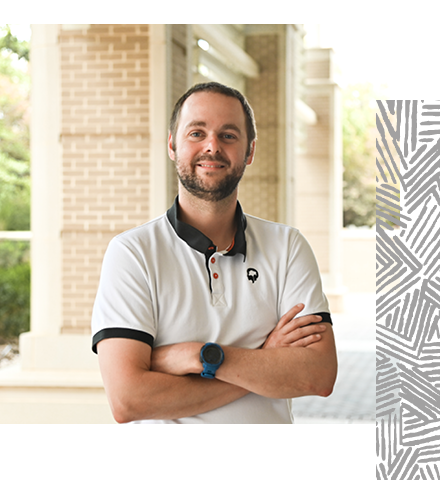We all want to be healthy and fit, but sometimes life gets in the way. We’re too busy to cook a proper meal, so we grab fast food instead. We want to take that evening walk, but it’s too hot outside. We could go to the gym, but we’re really engrossed in an article on our phone … or some TikTok videos.
Researchers at the University of South Carolina understand both the benefits and the challenges of getting people to exercise — as well as the societal repercussions when they don’t. Physical activity improves overall health and can help reduce the risk of chronic conditions such as obesity, heart disease and type 2 diabetes.
From studying children’s physical activity to exploring how the military can address the physical readiness of incoming recruits, researchers at the Arnold School of Public Health and beyond are dedicated to improving health trends to the benefit of both individuals and the broader society.
Below, we look at some of the efforts underway at the University of South Carolina to address the causes and high costs of physical inactivity.
When Russ Pate began researching children and physical activity in the 1970s, people didn’t see a need for learning how to get kids to be more active.
Nearly 50 years later, the data he and other researchers collected sets a foundation for discussion of today’s crisis of obesity and physical inactivity among youth.
“I figured out a long time ago that boredom avoidance is a real driver for kids, and back then staying inside the house was not that interesting — there weren’t laptops or cable TV or cell phones,” Pate says.
Pate’s research emphasizes that children who are more active are at lower risk of becoming overweight or obese than less active children. And kids with better strength, fitness and endurance generally have fewer risk factors for chronic conditions later in life such as disease and diabetes.
It’s not just physical health that’s a concern, either.
“Our field is increasingly interested in brain and mental health, and it’s clear that more active kids show better profiles for anxiety and risk of depression and so on,” Pate says.
Pate points to the COVID pandemic in particular as a factor that has changed the landscape for kids.
“We’re in this immediate post-COVID era where we’re hearing a lot about mental health issues in kids. In a sample of kids that we are studying, those who were more physically active during the pandemic were at lower risk of negative mental health outcomes,” he says.
READ MORE ABOUT PATE’S RESEARCH
Sarah Burkart’s ‘aha!’ moment as a research scientist came several years ago while working on a project to promote physical activity among preschoolers. One of the participating teachers said that if children do not get an adequate amount of sleep at night, they’re not ready to learn and can be uncooperative.
At that point, she realized she needed to look at more than just physical activity. Burkart, an assistant professor of exercise science at the Arnold School of Public Health, shifted her focus to children’s sleep health and joined a team of USC researchers who take a holistic approach to promoting children’s well-being, including physical activity, nutrition, behavior and sleep.
Burkart is finalizing a sleep promotion intervention program aimed at aiding parents of preschool and elementary kids in a Midlands-area school district to develop routines that make it easier to get children to sleep on school nights. The study, funded by the university’s Research Center for Child Well-being and the National Institutes of Health, began with Burkart’s team asking teachers to describe the challenges of teaching young children who arrive at school with inadequate sleep.
“What we heard is that sleep-deprived kids are missing out on academic content,” Burkart says. “They’re sleeping through morning lessons or maybe they stay awake in the morning but end up sleeping through lunch and recess, so they’re missing out on nutrition and a time to be physically active. Some of the teachers talked about behavioral concerns — not being able to interact well with their peers or with the teacher.”
Burkart hopes to develop tools to assist parents in developing better bedtime routines.
“The idea is to foster removing screens from that bedtime routine and replacing them with more calm activities,” she says.
Burkart’s pilot sleep promotion intervention is planned for the coming spring and a larger project, involving several more schools, is planned for fall 2024.
More about Burkart’s sleep study
Over the last decade, Arnold School researcher Glenn Weaver and his team have worked with schools and local community organizations to reduce childhood obesity. He has recently been awarded two grants – totaling $5.7 million – from the National Institute of Diabetes and Digestive and Kidney Diseases to explore whether healthy structured programming can reduce obesity and mitigate weight gain that often happens in the summer. Specifically, Weaver is studying whether a continuation of school-like conditions through camps and other programming can lessen or even reverse these effects.
“Virtually all increases in body mass index among children ages 5 to 12 occur during the summer break from school — regardless of their weight status prior to the end of the school year,” says Weaver, an associate professor of exercise science. “Pre-planned, segmented and adult-supervised environments – like those found in school and after-school programming – protect children against obesity-inducing behaviors such as sedentary screen time and unhealthy eating.”
Weaver’s research is based on the Structured Days Hypothesis, which states that adult-monitored and structured activities can help reduce obesogenic behaviors among children compared to what commonly occurs during summer.
Having demonstrated that their method works, the next steps involve fine-tuning programs to determine how many weeks of structured days are needed to achieve the desired results and working to ensure that the programming is accessible to vulnerable groups. These two new grants will enable the researchers to do just that.
Weaver says it’s important to manage children’s time: “Time filled with favorable activities, such as physical activity and healthy eating, cannot be filled with unfavorable activities,” Weaver says.
And, he says, summer camps have a key role to play.
“Community-operated day camps can exert a positive influence on summer BMI weight gain by offering structured environments that encourage healthy behaviors and limit unhealthy ones,” Weaver says.
Read more about Weaver’s research
A recent study from a team of researchers from several institutions, including the University of South Carolina, found the direct medical cost of treating musculoskeletal injuries among U.S. Army recruits was $14.89 million in 2017. About 48 percent of that amount was used to treat recruits from eight Southern states.
The results are consistent with previous research showing Army trainees from the South have lower physical fitness and higher incidence of musculoskeletal injuries, and that poor physical fitness is a strong predictor of injury risk among Army trainees. But this study put a price tag on what those injuries are costing the country.
“You could argue that it’s affecting us with health care costs and so on, but the most direct, and frankly, perhaps the scariest part is we’re having trouble recruiting into our military,” says Daniel Bornstein, who earned his Ph.D. from USC’s Arnold School of Public Health and now chairs the military sector of the National Physical Activity Plan. “We’re having trouble keeping people in the military. We’re having trouble keeping up with our ‘near peer’ adversaries. And if we go to war? We may lose because we’re not physically fit enough to fight the enemy. That’s the reality.”
The broader issue of physical fitness — in the military and beyond — is deep and long-standing, with few easy answers or quick fixes.
And it’s a research area that faculty at the University of South Carolina have been studying for decades.
“Yes, we can do some things to get troops ready … but really we’re talking about system-level changes that would impact kids from the early stages of life to have them grow up in these more optimal, health promoting environments,” says Michael Beets, an Arnold School exercise science professor and one of the authors of the study.
READ MORE ABOUT PHYSICAL FITNESS AND MILITARY READINESS
Many children are not only minimally participating in physical activity but also have fallen behind in acquiring basic motor development skills, dramatically hindering their capability to play, according to David Stodden, a University of South Carolina professor of physical education.
Stodden calls the trend an epidemic of functional movement decline.
“Seventy-five percent of children are at the 25th percentile and below based on normative motor skill development levels, which means far too many kids are at risk for long-term developmental delay,” says Stodden.
“They don't have the skills to be able to successfully participate in sports or even in recess, physical education and playing with others,” Stodden says. “They don't have the functional coordination and control to be able to get themselves up a slide or play on other playground equipment — they can’t play.”
As disturbing as the trend is, Stodden says parents can be part of the solution simply by going outside with their children — and moving with them.
READ MORE ABOUT STODDEN’S RESEARCH





